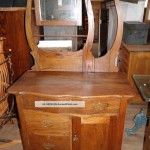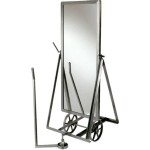How To Determine If a Mirror Is Two-Way
Concerns about privacy in public spaces and even private residences have led to increased awareness of two-way mirrors, also known as one-way mirrors. These mirrors appear reflective from one side while allowing visibility from the other. Identifying whether a mirror is two-way requires employing various techniques and understanding the principles behind their functionality. This article outlines several methods for determining if a mirror is a standard reflective surface or a two-way observation device.
A two-way mirror functions by having a thin, semi-transparent coating of reflective material. This coating allows a portion of light to pass through the surface to the observation side, while the remaining light is reflected back to the viewer on the "mirror" side. For the two-way effect to work effectively, the observation side must be significantly darker than the mirror side. This difference in illumination creates the illusion of a standard mirror for the person on the brighter side, while enabling someone on the darker side to see through the mirror.
The Finger Nail Test: A Common Misconception
One of the most commonly cited methods for identifying a two-way mirror is the “fingernail test.” This involves placing a fingernail against the surface of the mirror and observing the gap between the fingernail and its reflection. The premise is that a standard mirror will have a noticeable gap because the reflective coating is on the back of the glass, whereas a two-way mirror, with its coating on the surface, will appear to have no gap. While this method is widely circulated, it is unreliable and often misleading.
The fingernail test's inaccuracy stems from variations in mirror manufacturing and glass thickness. Even standard mirrors with thin glass may exhibit a minimal gap, creating the false impression of a two-way mirror. Conversely, a two-way mirror with a thicker glass pane might still show a discernible gap, leading to a false negative. Relying solely on this test is therefore not advisable.
The Tap Test: Listening for Differences in Sound
A more reliable method for differentiating between a standard mirror and a two-way mirror involves tapping on the surface and listening to the resulting sound. A standard mirror, typically installed against a solid wall, will produce a dull, flat sound because the solid surface dampens the vibrations. A two-way mirror, on the other hand, is often installed as a panel with a hollow space behind it, creating a more hollow, echoey sound when tapped.
To perform the tap test effectively, tap firmly but gently on different areas of the mirror's surface. Pay close attention to the sound produced. If the sound is consistent and dull across the entire surface, it is likely a standard mirror. If you notice variations in sound, particularly a hollow or echoey resonance, it could indicate a space behind the mirror, suggesting it might be a two-way mirror.
The effectiveness of the tap test depends on the installation of the mirror. If a two-way mirror is installed directly against a solid wall, the hollow sound may be muffled, making it difficult to distinguish from a standard mirror. However, in most installations where a two-way mirror serves as an observation panel, there will be a cavity behind the glass.
The Light Test: Observing the Light Transmission
Another, more definitive method for identifying a two-way mirror involves manipulating the lighting conditions on either side of the mirror. This test relies on the principle that a two-way mirror functions based on a significant difference in light levels. To perform this test, darken the room you are in as much as possible and shine a bright light, such as a flashlight, directly onto the surface of the mirror.
If the mirror is a standard mirror, it will simply reflect the light back into the room. However, if it is a two-way mirror, you may be able to see through the mirror to the other side. The bright light shining on the surface will overwhelm the reflective properties of the coating, allowing you to observe what is on the other side. If you can see even faint shapes or light coming from the other side, it is highly likely that the mirror is two-way.
The success of this test is dependent on the difference in light levels. The darker your room is and the brighter the light you shine on the mirror, the easier it will be to see through a two-way mirror. If the other side is brightly lit, it will be easier to detect activity or objects behind the mirror. A thorough examination of the mirror's surface while shining the light is crucial to detecting any signs of transparency.
Examining the Edges and Back: Looking for Clues in Construction
A physical examination of the mirror's edges and back can sometimes provide clues about its nature. If possible, carefully inspect the edges of the mirror. A standard mirror typically has sealed edges to prevent moisture from damaging the reflective backing. A two-way mirror, especially if installed as a panel, might have different edge finishing or visible mounting hardware.
If access to the back of the mirror is possible, examining its construction can be highly revealing. A standard mirror typically has a solid backing material that protects the reflective coating. A two-way mirror, on the other hand, may have a thinner or more open backing structure, allowing for observation from the other side. The presence of wiring or other surveillance equipment in the space behind the mirror is a strong indication that it is a two-way mirror used for monitoring or recording.
Exercise caution when attempting to examine the back of a mirror, as some installations may be difficult or potentially hazardous to access. If you are unsure about how to safely access the back of the mirror, it is best to consult with a professional.
Considering the Context: Evaluating the Environment
Finally, consider the context in which the mirror is located. The location and purpose of the room can provide valuable clues about the likelihood of a two-way mirror being present. For example, a mirror in a public changing room, bathroom, or hotel room should be scrutinized more carefully than a mirror in a residential living room.
Pay attention to any unusual features in the room, such as odd angles, hidden compartments, or surveillance equipment. If the mirror is in a location where observation might be considered inappropriate or illegal, it is wise to exercise extra caution and employ the tests described above to determine its nature.
The presence of security cameras or other monitoring devices in the vicinity of the mirror should raise suspicion. In such cases, it is essential to carefully examine the mirror and report any concerns to the appropriate authorities or management.
In summary, while the fingernail test is widely known, it is not a reliable method for identifying two-way mirrors. The tap test, light test, examination of edges and back, and consideration of context offer more accurate methods for determining if a mirror is a standard reflective surface or a two-way observation device. Employing a combination of these techniques will provide a more comprehensive assessment and help ensure privacy and security.

How To Tell If A Mirror Is Two Way Or Not 8 Steps With Pictures

How To Detect A Two Way Mirror Fingernail Test

How To Tell If A Mirror Is Two Way Or Not 8 Steps With Pictures

How To Tell If A Mirror Is Two Way Or Not 8 Steps With Pictures

How To Tell If You Re In A Room Restroom Motel Etc With Mirror Or

How To Tell If A Mirror Is Two Way Or Not 8 Steps With Pictures

How To Tell If A Mirror Is Two Way Or Not 8 Steps With Pictures

How To Tell If A Mirror Is Two Way Or Not 8 Steps With Pictures

How To Detect A Two Way Hotel Mirror

Double Sided Mirror Useful Life S Simple








